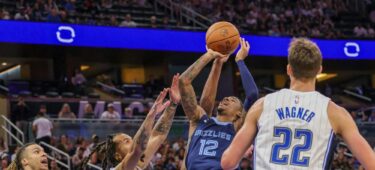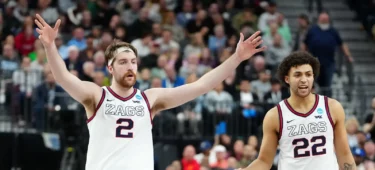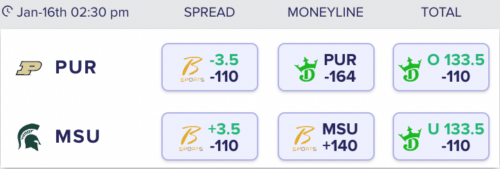
NCAAB ODDS COMPARISON & STANDINGS
Here are the best college basketball bets for every game, which we found using a new tool that sorts the data from every legal U.S. sportsbook.
ncaab future odds
ncaab BETTING GUIDES

Differences Between Betting on the NBA and College Basketball
Learn the differences between betting on the NBA and college basketball with this guide. Read about differences in spread, totals, schedules, and more. There are many differences between betting on the NBA and betting on college...
Read more Differences Between Betting on the NBA and College Basketball
The Best College Basketball Betting Strategy
Find the best college basketball betting strategy and start making winning college basketball picks. Read about major lines, small school lines, and more. Many college basketball experts have their own system when it comes to betting...
Read more The Best College Basketball Betting Strategy
How to Bet on College Basketball
Betting on college basketball is unique because of the sheer numbers of games you can bet on. With 350 Division I college basketball teams there is enough action to keep a person busy betting all winter. Due to the magnitude of NCAAB, it...
Read more How to Bet on College BasketballFinding The Best Bets For Every Game
At Sidelines, we have scoured the internet using our proprietary technology, to find the best bets available for every college basketball game. 15 different sportsbooks might have a team with -112 odds, but we can find the one book offering -110 odds, in order to offer you the best odds today, and everyday, for every college basketball game.
We have taken the consensus odds from every legal U.S. sportsbook and then found the best odds for each bet on every game, which is why the moneyline may show a line from Bally’s Sports and the total could be from DraftKings.
The Three Most Common College Basketball Bets
There are 100 different ways to bet on college basketball, but the three most common types of bets are on the spread, moneyline, and total. Let’s break them down:
Here’s an example of how a single NCAAB game looks with your three standard betting types:

- Spread: The most popular bet you can make on college basketball on is the spread; that’s the first set of numbers on the left. The green number represents how much a team is expected to win or lose by. In this example, Michigan State is +3.5, so if you bet on the Spartans to cover the spread, they need to come within 3.5 points of winning for you to win your bet.
If you bet on Purdue -3.5, they’ll need to beat Michigan State by at least 3.5 points for you to win your bet. The -110 in blue represents the odds of what you’re betting on. -110 means for every $110 you wager, you’ll win $100.
- Moneyline: The next thing you can bet on is the moneyline. In sports betting, making a bet on the moneyline is just betting that a team will win, straight up, regardless of the score. The odds you see determine how likely your bet is to win. The team with a “-” next to their odds number means they’re the favorite and the team with a “+” is the underdog.
In our example game above, Purdue is favored to win but only by 3.5, so you’d need to bet $164 to win $100 on a Purdue bet.
Michigan State on the other hand are the underdogs here so if you bet $100 on them and they win, your return would be $140. In games that are expected to be close, the moneyline odds numbers are generally between 100-200 in both directions
- Total (over/under): Finally, we have the total, or over/under. The winner or loser has no effect on the total, only how many points are scored by both teams combined. Oddsmakers will set a total points number, and you can bet on if the teams will combine for more or less than that amount.
In our example above, the total is 133.5. Much like the spread, the odds are relatively even on both sides, so you just bet on whether the game will be high or low scoring.
If you want to learn how to bet on college basketball those are the three most common types of bets, but there are many other types of NCAAB bets you can make.
Other Popular College Basketball Bets
- Futures: A bet on a future event that will be determined at the end of a season. For example, who will win the Wooden award, which team will win the NCAA tournament, or which team will win each conference.
- Props: A prop is betting on an event that will happen in a game. For example, a game prop like “who will score the first basket of the game”? Or a player prop like “will Zach Edey grab over/under 10.5 rebounds”? There are endless amounts of prop bets you can bet on in any given game.
- Parlays: A parlay betting is a string of bets wagered as one bet. For example, Purdue, Villanova, and Illinois could all have games on the same night. If you think each of those teams will cover their spread, you can parlay them together, and instead of three separate bets with odds of -110 or -105, you’ll have one bet with odds of around +600. The catch is that all three things you’re betting on need to happen in order for you to win anything.
- Win Margin:Win Margin is betting on the exact amount of points a team will win by. Your odds will vary depending on how wide of a margin you’re betting on, and if you’re betting that the favorite or the underdog will win.
- Halves and Quarters: Sports games are usually divided into halves, quarters, or both. So, anything you can bet on for the course of a full game (spread, moneyline, total, etc…) can also be bet on a half or a quarter of a game
You bet on college basketball the same way you would in any other sport. Every game has a spread, a moneyline, an over/under, and various other types of bets you can place. With college basketball, you might see outrageous spreads and moneylines as there are 352 teams and vastly different levels of play. During non-conference play, a team from a power-5 conference could be favored by 40+ against a team from a significantly weaker conference.
When looking at odds, college basketball or otherwise, the higher number a team has next to a “-”, the more likely that team is to win. That team is the favorite. The higher the number is next to a “+”, the less likely that team is to win. They are the underdogs. If Purdue is listed at -164 and Michigan State is listed at +140, that means oddsmakers think it’s a bit more likely Purdue comes out with a win.
For information on reading and understanding odds and their associated payouts, check out the Sidelines odds calculator.
While sportsbooks do utilize advanced metrics, statistics, and available sports data to create algorithms that help set lines, the chief concern for legal online sportsbooks in setting college basketball odds is minimizing their risk. Meaning, sportsbooks ideally have an equal amount of money wagered on either side of a given bet. This is meant to ensure a profit, as they simply use the losing side of the bet to pay the winning side, while pocketing the vig (also known as “juice”) they charge for taking on your bet. In order to ensure this situation ultimately plays out, they will adjust the lines accordingly in order to attract more money to a particular side of a bet.
ncaab standings
ncaab SCHEDULE














































































































































































































































































































































































